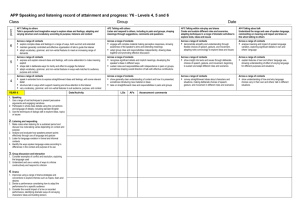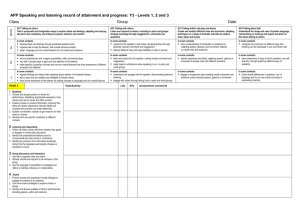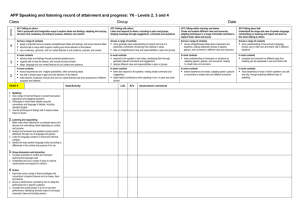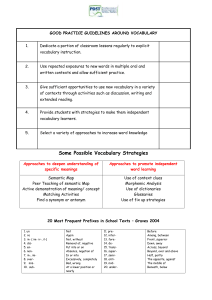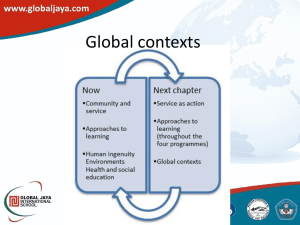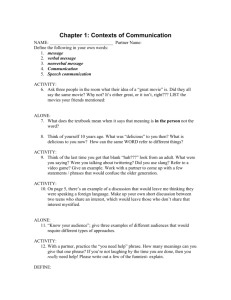2. Listening and responding
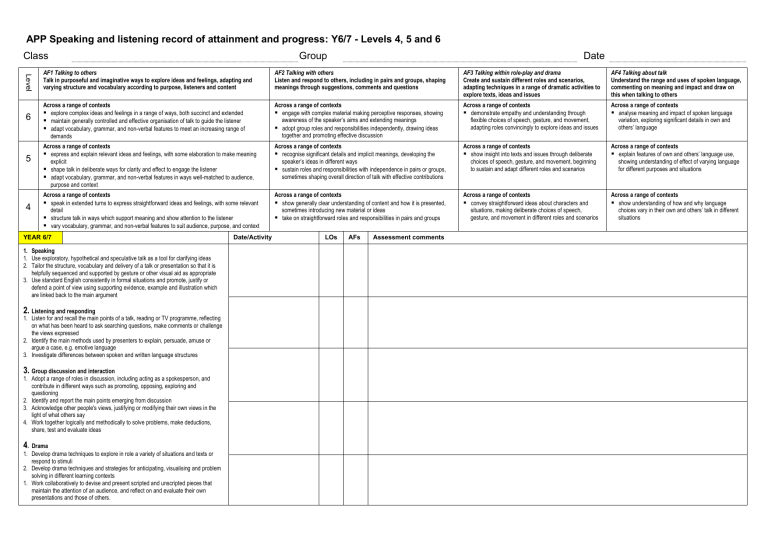
APP Speaking and listening record of attainment and progress: Y6/7 - Levels 4, 5 and 6
Class
AF1 Talking to others
Talk in purposeful and imaginative ways to explore ideas and feelings, adapting and varying structure and vocabulary according to purpose, listeners and content
Group
AF2 Talking with others
Listen and respond to others, including in pairs and groups, shaping meanings through suggestions, comments and questions
6
5
4
Across a range of contexts
explore complex ideas and feelings in a range of ways, both succinct and extended
maintain generally controlled and effective organisation of talk to guide the listener
adapt vocabulary, grammar, and non-verbal features to meet an increasing range of demands
Across a range of contexts
express and explain relevant ideas and feelings, with some elaboration to make meaning explicit
shape talk in deliberate ways for clarity and effect to engage the listener
adapt vocabulary, grammar, and non-verbal features in ways well-matched to audience, purpose and context
Across a range of contexts
speak in extended turns to express straightforward ideas and feelings, with some relevant detail
structure talk in ways which support meaning and show attention to the listener
vary vocabulary, grammar, and non-verbal features to suit audience, purpose, and context
YEAR 6/7 Date/Activity
Across a range of contexts
engage with complex material making perceptive responses, showing awareness of the speaker’s aims and extending meanings
adopt group roles and responsibilities independently, drawing ideas together and promoting effective discussion
Across a range of contexts
recognise significant details and implicit meanings, developing the speaker’s ideas in different ways
sustain roles and responsibilities with independence in pairs or groups, sometimes shaping overall direction of talk with effective contributions
Across a range of contexts
show generally clear understanding of content and how it is presented, sometimes introducing new material or ideas
take on straightforward roles and responsibilities in pairs and groups
Assessment comments
1.
Speaking
1.
Use exploratory, hypothetical and speculative talk as a tool for clarifying ideas
2.
Tailor the structure, vocabulary and delivery of a talk or presentation so that it is helpfully sequenced and supported by gesture or other visual aid as appropriate
3.
Use standard English consistently in formal situations and promote, justify or defend a point of view using supporting evidence, example and illustration which are linked back to the main argument
2.
Listening and responding
1.
Listen for and recall the main points of a talk, reading or TV programme, reflecting on what has been heard to ask searching questions, make comments or challenge the views expressed
2.
Identify the main methods used by presenters to explain, persuade, amuse or argue a case, e.g. emotive language
3.
Investigate differences between spoken and written language structures
3.
Group discussion and interaction
1.
Adopt a range of roles in discussion, including acting as a spokesperson, and contribute in different ways such as promoting, opposing, exploring and questioning
2.
Identify and report the main points emerging from discussion
3.
Acknowledge other people's views, justifying or modifying their own views in the light of what others say
4.
Work together logically and methodically to solve problems, make deductions, share, test and evaluate ideas
4
. Drama
1.
Develop drama techniques to explore in role a variety of situations and texts or respond to stimuli
2.
Develop drama techniques and strategies for anticipating, visualising and problem solving in different learning contexts
1.
Work collaboratively to devise and present scripted and unscripted pieces that maintain the attention of an audience, and reflect on and evaluate their own presentations and those of others.
LOs AFs
Date
AF3 Talking within role-play and drama
Create and sustain different roles and scenarios, adapting techniques in a range of dramatic activities to explore texts, ideas and issues
Across a range of contexts
demonstrate empathy and understanding through flexible choices of speech, gesture, and movement, adapting roles convincingly to explore ideas and issues
AF4 Talking about talk
Understand the range and uses of spoken language, commenting on meaning and impact and draw on this when talking to others
Across a range of contexts
analyse meaning and impact of spoken language variation, exploring significant details in own and others’ language
Across a range of contexts
show insight into texts and issues through deliberate choices of speech, gesture, and movement, beginning to sustain and adapt different roles and scenarios
Across a range of contexts
explain features of own and others’ language use, showing understanding of effect of varying language for different purposes and situations
Across a range of contexts
convey straightforward ideas about characters and situations, making deliberate choices of speech, gesture, and movement in different roles and scenarios
Across a range of contexts
show understanding of how and why language choices vary in their own and others’ talk in different situations
